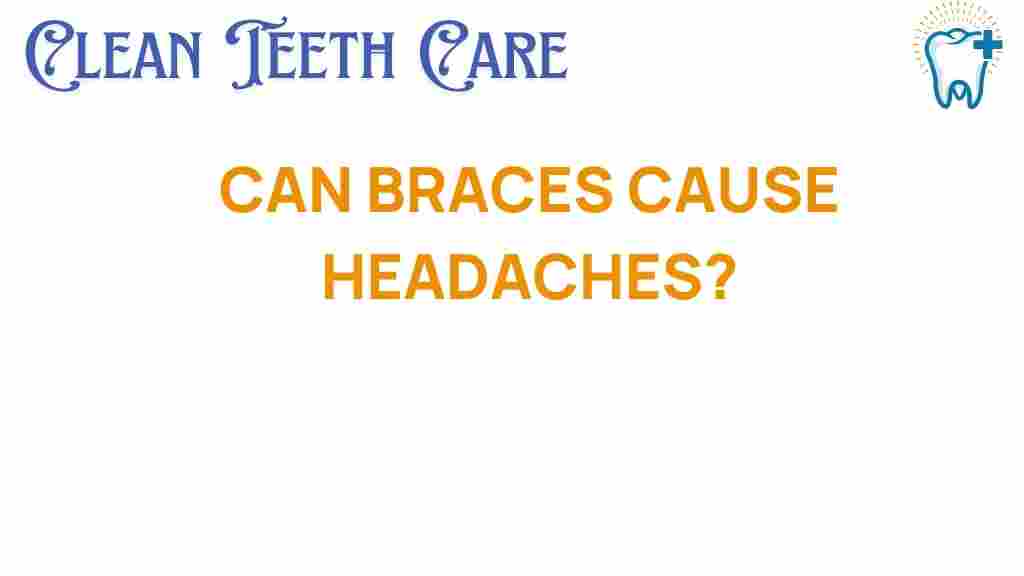Unraveling the Mystery: Can Braces Really Cause Headaches?
Braces are a common orthodontic treatment designed to straighten teeth, correct bite issues, and enhance overall dental health. However, many patients report experiencing headaches during their time with braces. This phenomenon raises questions and concerns among individuals considering orthodontic treatment. In this article, we will explore the relationship between braces and headaches, debunk myths, and provide insights into how to manage discomfort effectively.
Understanding the Connection Between Braces and Headaches
Headaches can be a frustrating experience, and when they occur during orthodontic treatment, they can lead to increased anxiety for patients. It’s essential to understand why some individuals may experience headaches while wearing braces.
- Pressure and Tension: Braces apply constant pressure to teeth and jaws as they work to move teeth into the desired position. This pressure can sometimes lead to muscle tension in the jaw, resulting in headaches.
- Jaw Pain: Discomfort in the jaw can be a significant factor contributing to headaches. When braces are adjusted, the shift in alignment can sometimes cause temporary jaw pain, which may radiate to the head.
- Changes in Bite: As teeth shift, changes in bite alignment can occur, leading to tension in the muscles responsible for jaw movement. This tension can manifest as headaches.
Common Myths About Braces and Headaches
With numerous opinions circulating about braces and their effects on health, it’s crucial to differentiate between fact and fiction. Here are some common myths regarding braces and headaches:
- Myth 1: All patients with braces will experience headaches.
- Myth 2: Braces cause permanent headaches.
- Myth 3: Headaches from braces indicate a problem with the treatment.
Understanding these myths can help alleviate concerns and provide a clearer perspective on what to expect during orthodontic treatment.
Step-by-Step Process: What to Expect with Braces
The journey with braces involves several stages, each of which can impact your dental health and overall comfort. Here’s a breakdown of what to expect:
- Initial Consultation: Your orthodontist will evaluate your dental health and determine if braces are the right solution for you.
- Placement of Braces: Once you decide to proceed, braces will be placed on your teeth. This is typically a painless procedure, but you may feel some pressure.
- Adjustment Appointments: Regular visits to your orthodontist for adjustments can result in temporary discomfort and potential headaches as your teeth shift.
- Removal of Braces: After your treatment period, braces will be removed, and you may receive a retainer to maintain your new smile.
Managing Discomfort and Headaches During Orthodontic Treatment
While some discomfort is normal during orthodontic treatment, there are several strategies to manage and alleviate headaches and jaw pain:
- Over-the-Counter Pain Relievers: Non-prescription medications like ibuprofen or acetaminophen can help relieve tension and discomfort.
- Warm Compresses: Applying a warm compress to the jaw can ease muscle tension and reduce headache symptoms.
- Maintain Good Oral Care: Keeping your teeth and braces clean can help prevent additional discomfort and complications.
- Stay Hydrated: Dehydration can exacerbate headaches; ensure you drink plenty of water throughout the day.
- Practice Relaxation Techniques: Stress can contribute to tension headaches, so consider practicing deep breathing or meditation.
When to Consult Your Orthodontist
If headaches persist or become severe, it may be time to consult your orthodontist. They can assess your treatment and determine if any adjustments are necessary. Signs that warrant a visit include:
- Headaches that are frequent and debilitating.
- Jaw pain that interferes with daily activities.
- Changes in bite that seem concerning.
Your orthodontist can provide guidance tailored to your specific situation, ensuring that your patient experience is as comfortable as possible.
Patient Experience: Testimonials and Insights
Many patients share their experiences with braces, including the challenges they faced and how they overcame them. Here are a few highlights from real patient testimonials:
- “I felt pressure and some headaches after my first adjustment, but my orthodontist reassured me that it was normal. They recommended pain relievers and heat packs, which helped a lot.”
- “At first, I thought my headaches were due to my braces, but my orthodontist explained that it was more about adjusting to the new alignment.”
- “I was surprised to learn that staying hydrated made a difference in my overall comfort during treatment.”
These insights provide reassurance to those starting their journey with braces, highlighting that while challenges may arise, they are often manageable.
Conclusion: Embracing Orthodontic Treatment with Confidence
In conclusion, while braces can sometimes lead to headaches due to pressure, tension, and jaw pain, these experiences are typically temporary. Understanding the connection between braces and headaches can empower patients to manage their discomfort effectively. By addressing myths and following practical tips, individuals can navigate their orthodontic treatment with confidence.
Remember, maintaining good oral care, staying informed, and communicating with your orthodontist are key to a successful and comfortable experience. For more information on oral care and orthodontic treatment, visit Dental Health Resources.
If you have further questions about braces and headaches, don’t hesitate to reach out to your orthodontist. They are there to help you achieve the smile you’ve always wanted while ensuring your comfort throughout the process.
This article is in the category Conditions and created by CleanTeethCare Team
